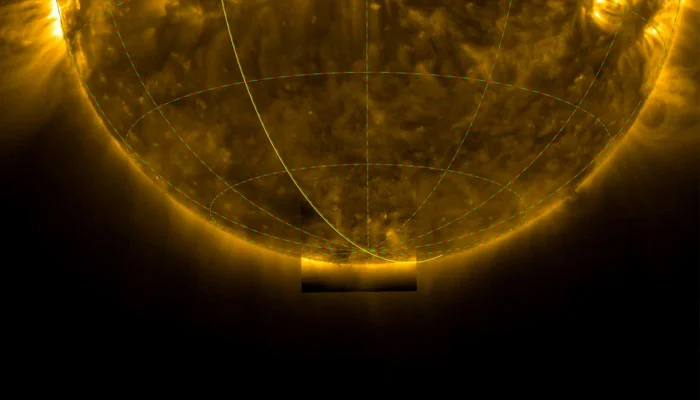New images captured by the Solar Orbiter spacecraft have provided an unparalleled view of the Sun’s south pole, revealing a turbulent and intricate magnetic field as our star approaches the peak activity phase of its natural cycle. These pioneering images, officially released on Wednesday by the European Space Agency (ESA), represent a significant advancement in heliophysics, offering novel insights into the Sun’s behavior, its magnetic field dynamics, and its influence on space weather, as reported by NBC News.
“The Sun is our nearest star, giver of life and potential disruptor of modern space and ground power systems, so it is imperative that we understand how it works and learn to predict its behaviour,” stated Carole Mundell, director of science at ESA. She further emphasized that these “new unique views from our Solar Orbiter mission are the beginning of a new era of solar science.”
Heliophysicists are already benefiting from these observations, which clearly show intense magnetic activity at the south pole as the Sun prepares for its solar maximum. The Sun’s natural cycle spans approximately 11 years, transitioning from a quiescent period of low magnetic activity to a highly active phase characterized by powerful solar flares and geomagnetic storms. During the solar maximum, the Sun’s magnetic poles undergo a reversal, with the south pole acquiring magnetic north polarity.
While the precise mechanisms behind this magnetic flip and its exact timing remain subjects of ongoing research, the data from the Solar Orbiter may prove crucial in unraveling these mysteries. Scientists have noted that the Sun’s south pole currently exhibits a complex mixture of magnetic fields displaying both north and south polarities. This magnetic “mishmash” is anticipated to be a temporary phenomenon, persisting only during the solar maximum before the magnetic field fully flips.
Once the magnetic reversal is complete, a single polarity is expected to gradually become dominant at the poles as the Sun transitions towards its quieter solar minimum phase. “How exactly this build-up occurs is still not fully understood, so Solar Orbiter has reached high latitudes at just the right time to follow the whole process from its unique and advantageous perspective,” explained Sami Solanki, director of the Max Planck Institute for Solar System Research in Germany and lead scientist for Solar Orbiter’s PHI instrument, which meticulously maps the Sun’s surface magnetic field.
Previous close-up images of the Sun have consistently been captured from around its equator by spacecraft orbiting along a plane similar to Earth’s. However, the Solar Orbiter’s distinct trajectory has enabled the spacecraft to tilt its orbit, thereby achieving higher-than-normal solar latitudes. The newly released images were acquired in late March, when the Solar Orbiter was positioned 15 degrees below the Sun’s equator, and then a few days later at 17 degrees below the equator. This elevated vantage point provided the probe with its first direct view of the Sun’s south pole.
Launched in February 2020, the Solar Orbiter is a collaborative mission undertaken by the ESA and the National Aeronautics and Space Administration.



